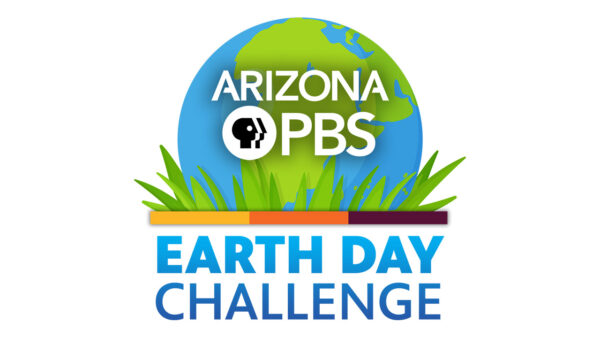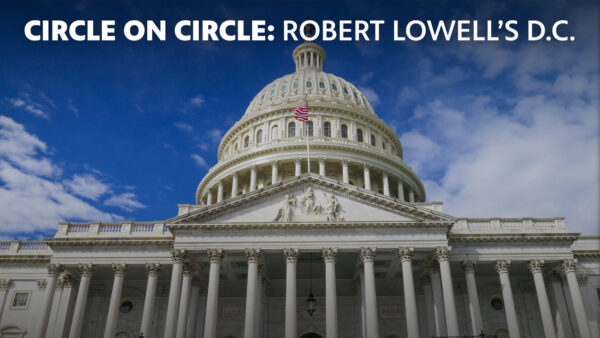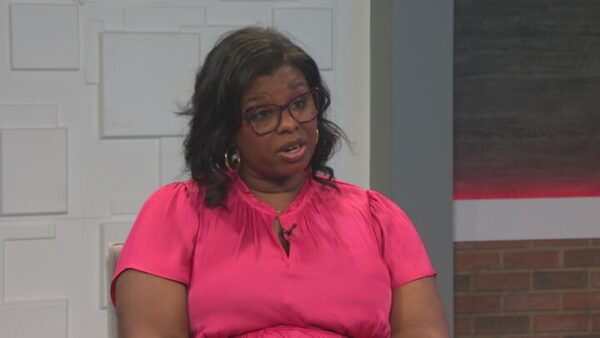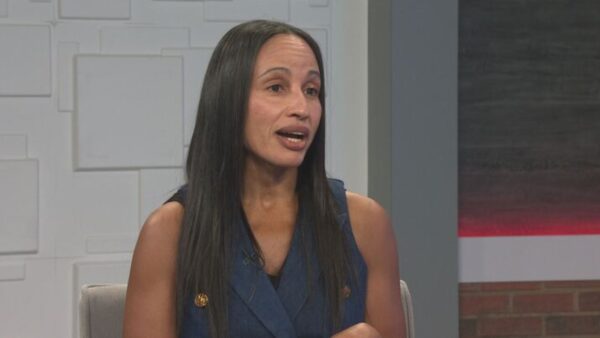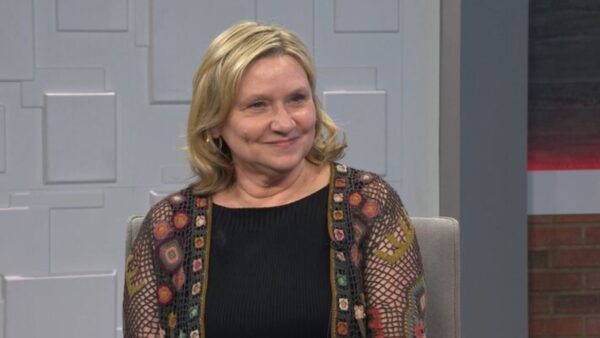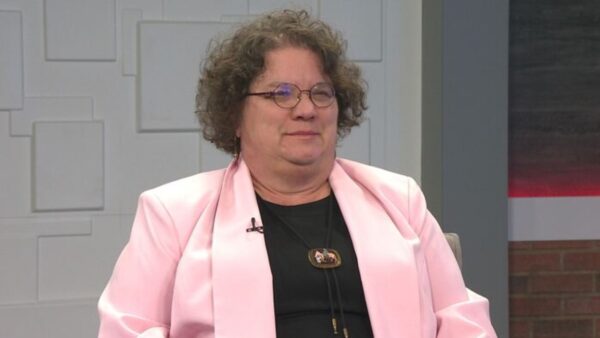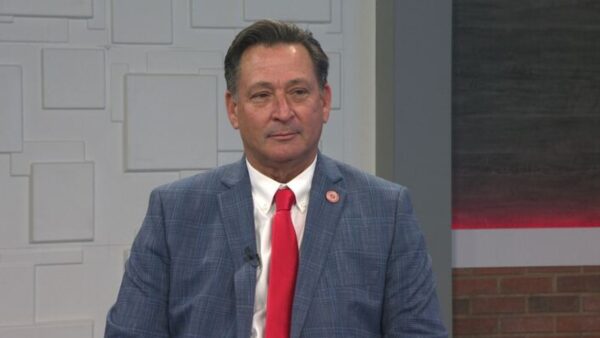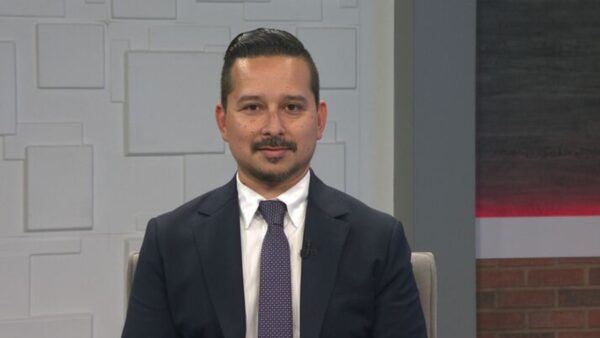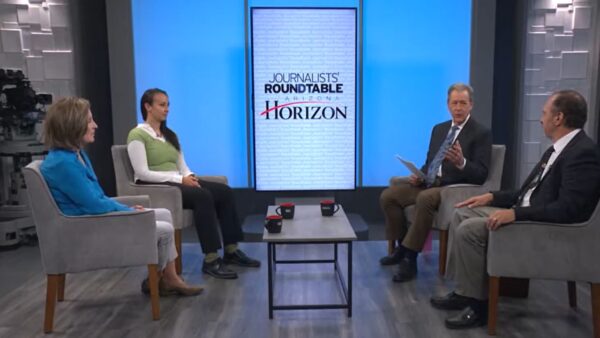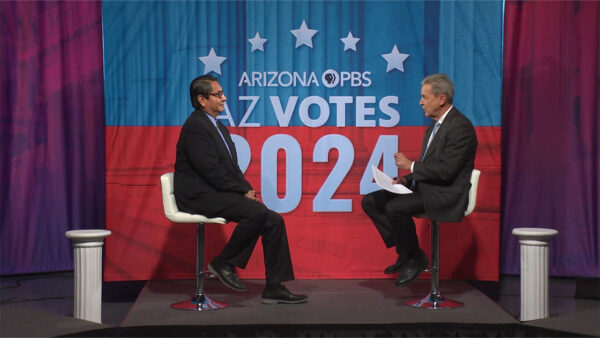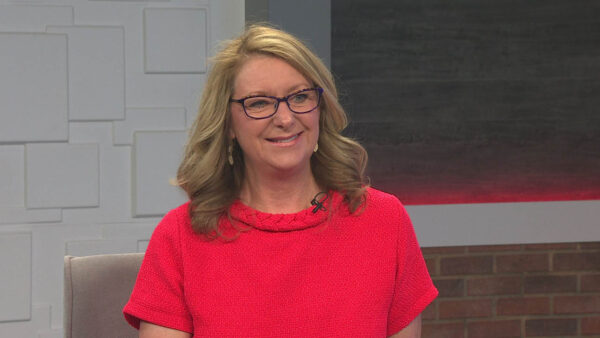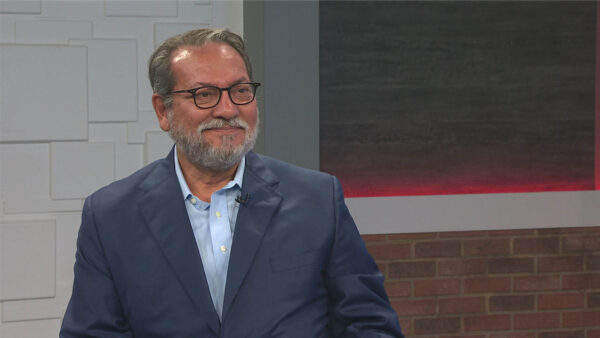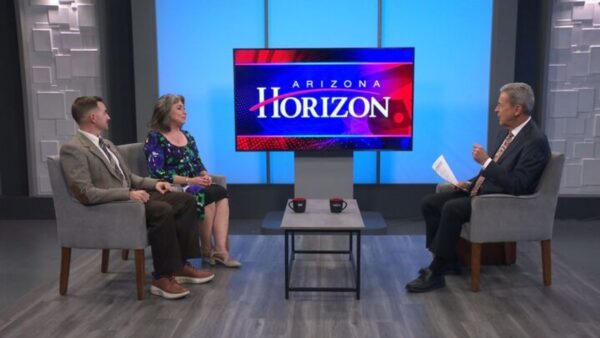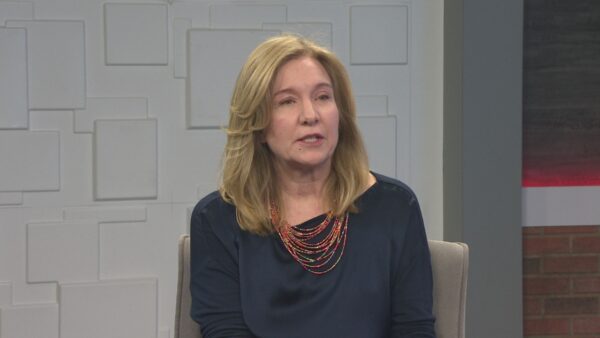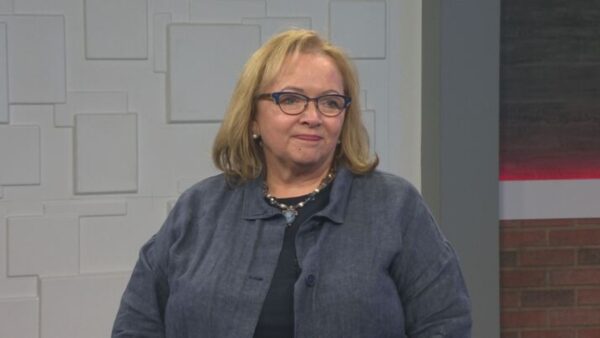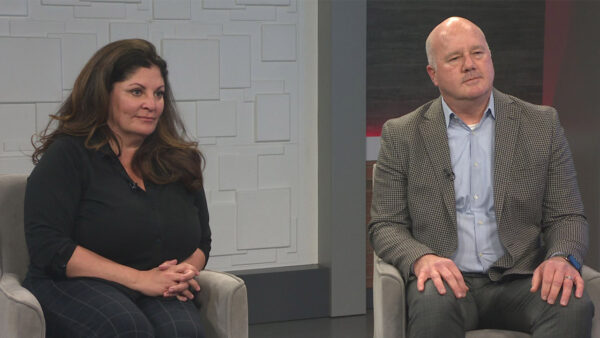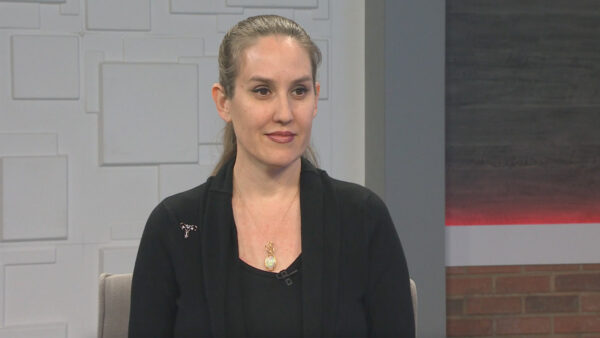HORIZON begins a four-part series on Arizona’s emergency management plan. In the wake of Hurricane Katrina’s impact on the Gulf Coast, we see what preparations our state has in place. Tonight, we examine what potential disasters could affect Arizona. Our guests include Leah Farr, President-Elect of the Arizona Emergency Services Association board.
>> Michael Grant:
Tonight on "Horizon", we begin a four-part series looking into whether Arizona is prepared for disaster. Tonight, what type of disaster might we have here in our state. Two nuclear reactors back online at Palo Verde, an update on the station's status. And we visit the only museum in the world dedicated to the art of beadmaking on tonight's "Arizona Story."
>> Announcer:
Horizon is made possible by the friends of Channel 8, members who provide financial support to this Arizona PBS station. Thank you.
>> Michael Grant:
Good evening. Welcome to "Horizon." I'm Michael Grant. The Associated Press is reporting that potential gubernatorial candidate Mary Peters may not meet the state's residency requirement. Peters' rival, John Green, says Peters is registered to vote in Virginia. She claims she bought a home in Virginia while serving for the Bush Administration. The Arizona constitution requires that a governor must live in the state for five years preceding the election.
>> Michael Grant:
Governor Janet Napolitano says states should lead the response to natural disaster. She spoke last week before the house homeland security committee in Washington. In the wake of catastrophic disasters in the Gulf States, many authorities have taken a second look at their own state's preparedness. Tonight, we start a four-part series, "Disaster! Is Arizona Prepared?" We'll take a look at many facets of the issue. Tonight, just what can we expect in terms of disaster? Larry Lemmons takes us to a mock disaster exercise.
>> Radio:
Command, go ahead.
>> Radio:
We need help some help. Also want to let you know we have an armed suspect in the U-Haul van.
>> Larry Lemmons:
A stolen van is spotted by the Department of Public Safety.
>> Radio:
All units respond.
>> Larry Lemmons:
A chase results in a collision with a tanker caring anhydrous ammonia.
>> Radio:
We have additional resources coming.
>> Radio:
10-4.
>> Larry Lemmons:
Inmates happen to be working in the area while a crafts fair is under way. Several people are overcome by toxic fumes. This is a disaster on a simulated Casa Grande intersection. The mock exercise is conducted by local, county, state and federal emergency responders. Just as authorities reign in the chaos, another glitch.
>> Frank Navarette:
We just received word shortly of another cat -- some other casualties. One of the suspects had escaped and he was captured moments ago by three Casa Grande police officers. After he was apprehended, he was being searched and he had a backpack and unfortunately the backpack exploded and all four were killed, including the officers.
>> Larry Lemmons:
Frank Navarette is the Director of the Arizona Office of Homeland Security, Arizona Division of Emergency Management. He is on the phone with Governor Janet Napolitano describing the situation.
>> Governor Napolitano:
What about medical personnel?
>> Frank Navarette:
Medical personnel were in good shape.
>> Larry Lemmons:
Exercises like these ensure that first responders know what to do in an emergency.
>> Cam Hunter:
You know, we work at it -- people may not see it, but we work at it on a daily basis, and it's through training, it's through exercises when responders aren't responding, you can be sure -- and the emergency planners are in preparing for this sort of thing.
>> Larry Lemmons:
Preparing for this sort of thing in New Orleans was apparently difficult for emergency management. As the crisis lingered like stagnant water, criticism of the federal emergency management agency grew.
>> Frank Navarette:
It's emotional because of what happened and the criticism that they received and fact that Mike Brown was asked to step down. There's also a lot of concern or discussion about the fact that some of the funding has been cut back for FEMA. Also the fact that more emphasis has been placed on terrorism as opposed to natural disasters. When you have more natural disasters than you do acts of terrorism. It's an open issue. Like I said, it's going to be up for a lot of debate.
>> Larry Lemmons:
Locally authorities say the lessons of recent disasters have not been lost on them. The lack of local communication after the hurricane was instructive.
>> Frank Navarette:
Well, we've taken several significant steps. One in particular is interoperability, the ability for disparate radio frequencies -- or first responders to communicate with each other. We've put equipment in place to allow us to do that during emergencies. Now, it's not a constant thing you can do because that fix would take hundreds of millions of dollars and quite a bit of time. But, for example, vehicles like this are a good example of the interoperability capability. With this vehicle we can tie in all of these first responders and they can talk to one another over the existing radio frequencies.
>> Larry Lemmons:
While authorities prepare for any disaster, in Arizona disasters occur that generally wouldn't threaten cooler or wetter areas.
>> Frank Navarette:
One is a massive Valley-wide electrical power failure would that last for months in the summer. That's got a ripple effect throughout -- it impacts commerce, impacts human safety, can you imagine that, people in trailers without air conditioning, elderly people, what do you do with people who need special care in nursing homes and the like? That is a big deal. Of course, we always deal with floods in Arizona. So we're pretty well prepared on that. The third one is wildfires. But we're also -- we also look very carefully and keenly at potential terrorist activities, something like this.
>> David Engelthaler:
So it's really because we've been planning for all hazards, which helps us to make sure that we are ready for anything. Within that, we look specifically obviously at things like Palo Verde and planning around Palo Verde. We look at infectious disease outbreaks, pandemic influenza is being discuss add lot lately, other types of large-scale infectious disease outbreaks, ones we don't know about but can be ready for, things like SARS, which came out of nowhere and also went away pretty quickly. Other things like bioterrorism attacks, other types of terrorism attacks which may have impact on health, lots of death, illness, those kinds of things. That's what we're doing a lot of preparing and planning for.
>> Larry Lemmons:
Whether natural or caused by human hands, disasters can strike with little warning, but exercises like these help responders to expect the unexpected and to react skillfully in the midst of chaos.
>> Michael Grant:
Before preparing for a disaster we need to consider what could possibly happen. Joining me now is the president-elect of the Arizona emergency services association, Leah Farr. Leah, thanks for joining us that.
>> Leah Farr:
It's a pleasure to be here.
>> Michael Grant:
Obviously in the past several months we have been focused on Metro area, wide-scale disasters, Katrina in New Orleans, obviously being most prominent.
>> Leah Farr:
Exactly.
>> Michael Grant:
You never want to say never, but realistically, are there very many things that could happen to the Valley, to the urban area, that would require emergency planning and reaction on that kind of scale here in the Valley of the sun?
>> Leah Farr:
Obviously we're not going to be looking at wide-spread panic and evacuation from a hurricane where we've got some leeway. We're probably looking at things like airplane crashes that are going to affect multiple cities, impact transportation, those kinds of things, flooding. We saw a little bit of that from SRP with roads but if we look at something like the Roosevelt Dam breaking, which they've done some studies on from the county perspective, we're looking at evacuations from that standpoint. Then any kind of chemical hazardous spill can that can escalate depending on what they come in contact with and some of the biological things we're looking at, coming up, like the pandemic, avian flu or any kind of influenza or biological types of events that are going to infect people or keep us to not have to evacuate but actually invacute or quarantine ourselves.
>> Michael Grant:
Obviously all of those things are possible, but probably more likely, and I don't mean to minimize that, because it could certainly impact several thousand, perhaps even tens of thousands of people, but probably more likely are some of the things that you were listing toward the end there, the chemical spills, you know, those kinds of things.
>> Leah Farr:
When you look at things that could start cascading, you could have multiple spills, things that cause other things to fail, that start impacting lots of power supplies, public transportation, infrastructure, telecom, those kinds of things that start coming when you get to hazardous chemical spills, eroding wires, getting the clouds that affect people that cause issues to happen.
>> Michael Grant:
Terrorism, of course, is one of the things that, unfortunately, we have to deal with and think about now that we did not before. Are there most likely terrorism disaster possibilities?
>> Leah Farr:
I imagine most of the things we're looking at from a terrorist perspective are weapons of mass destruction, things that are exploding, things that will have impact to people, that will cause panic, terror. Any kind of side effects from biological, radiological weapons. It's something we still need to take into effect. There have been a lot of articles about how we haven't been hit since 9/11, but that doesn't mean that the risk isn't there. We still need to think about them and understand what can happen. It doesn't necessarily need to happen from external terrorists, as well.
>> Michael Grant:
Certainly one of the things that occurred to a lot of people, isn't the direct natural disaster on your area but the impacts that a natural disaster can have in an adjoining state, for example California.
>> Leah Farr:
Right, it's the reason a lot of people move here, is they think we have great weather, lots of things don't happen, lot of Californians are moving here because we don't have earthquakes. So we need to be prepared to take evacuees from disasters in other states, whether it's California, New Mexico, Utah, any surrounding states, even potentially Mexico, should a natural disaster happen there.
>> Michael Grant:
For that matter, dispatching a fair amount of our own resources to a state that would be in those kinds of straits.
>> Leah Farr:
Exactly. We've got lots of mutual aid agreement between cities and counties, fire departments. They've all planned in advance to help with fires, chemicals, spills, those kinds of things, sharing metropolitan medical reserve system resources. They're all in place in advance to help make sure that when the calls are placed people are out immediately and know what they need to bring with them.
>> Michael Grant:
The mock disaster exercise we saw on tape, those are periodically conducted, are they not, in a variety of different potential disaster scenarios?
>> Leah Farr:
Right. The government obviously has to do them to test their plans, just like continuity planners at companies prepare them as well. Whether it's a quarterly basis, annual exercises such as mock disasters take a long time to prepare for, so they're usually done on an annual or biannual basis. Lots of plans are done in a table top exercise where they get around in a circle and start talking about the plans. Everything has to be tested. If it's not, you never know what's going to happen from a real incident.
>> Michael Grant:
Before we wrap up, the Arizona Emergency Services Association, just tell us a little bit about who that is.
>> Leah Farr:
Absolutely. It's a nonprofit professional association that services emergency responders, government planners, continuity planners, anyone in general that has dealings with doing emergency preparedness and response. So it's fire, police, nurses, emergency planners and we can be seen on the web at WWW.AZAESA.ORG.
>> Michael Grant:
OK, Leah Farr, thank you for the information.
>> Leah Farr:
Thank you so much.
>> Michael Grant:
We'll continue our series, "Disaster! Is Arizona prepared?" throughout the week. Palo Verde Nuclear Generating Station of course no stranger to preparedness. The plant is back online after a safety concern caused plant to cease operations. Here's some background on the recent shutdown.
>> Larry Lemmons:
The Palo Verde nuclear generating station took about 12 years to build and cost about $6 billion. It became fully operational in 1988. It employs about 2500 people and serves millions of people all across the Southwest. It has three combustion engineering pressurized water reactors with a total capacity of about 4,000 megawatts. APS operates the facility and is the majority owner, but SRP and other utilities also own a part of the station. It's located in Wintersburg, Arizona, about 50 miles west of Phoenix. One of the plant's generators had already been shut down for refuelling when on October 11th, the other two generators were shut down. Nuclear regulatory commissioners had raised questions about the emergency reactor cooling system. Apparently, a calculation done in the 1970s on which some of the emergency core cooling system is based, could not be validated. The question became, in the event of a loss of coolant accident, would the system flood the reactor with water? Physically testing the calculation would require flooding the reactor with hundreds of thousands of gallons of water. Calculations and modeling was done to show the system would work. The NRC met with Palo Verde officials to verify the conclusions and said APS could restart the units. The two units were brought back up October 22nd. The third will remain off line for the scheduled repairs and refuelling.
>> Michael Grant:
Here now with an update on the plant's operations status is the spokesman for the Arizona Public Service company, Jim McDonald. Jim, you were making the comment that toward the end there you wanted to clarify something?
>> Jim McDonald:
Sure. When we brought the units back online, that was our decision to do that. I do believe the NRC agreed, but we didn't need their permission to come back into service.
>> Michael Grant:
APS had actually taken it down on its own volition, had they not?
>> Jim McDonald:
That's correct. When we determined that this particular system -- we couldn't verify that it would indeed operate under all circumstances. We made the decision ourselves to take it offline.
>> Michael Grant:
What's the plant's current status right now?
>> Jim McDonald:
Units 2 and 3 are running at 100% power, running very, very well. Unit 1 is in a refuelling and maintenance outage.
>> Michael Grant:
And that will continue for some time -- that was scheduled?
>> Jim McDonald:
Yes, it was.
>> Michael Grant:
You know, Jim, Palo Verde obviously has been running, portions of it, had been running for close to 20 years. How was it that this question, this issue, given that long an operational track record comes up in late 2005?
>> Jim McDonald:
That's a very, very good question that doesn't have an easy answer. Not to be trite about it, it was a good question. It was a good question. It was a tough question. And one not easy to answer. The particular question, the way it was asked, it really involves the interaction between various systems that go from the nuclear portion of the plant to the non-nuclear, and will they work together? One was put in, manufactured, designed by one manufacturer, the other by a different one, and the requirements are that those systems can work together. The question was a complex one that required some thought and analysis to be sure, conservative operating philosophy, when we couldn't immediately answer it to our own satisfaction, we took those two units offline, which you don't do lightly, but it was the right decision at the right time.
>> Michael Grant:
It just seems to me, given, I mean, the nuclear power industry has been around for quite some time, Palo Verde has been around for quite some time, and incidentally, for the past ten years or so running at peak nationwide and worldwide, it just strikes me as absolutely amazing that somebody could come up with, as you put it, a good question at this point in time.
>> Jim McDonald:
Well, I'm sure that it does seem that way, but, again, a nuclear power plant, you run with a conservative operating philosophy. These plants are never unsafe. I need to emphasize that. But what you're talking about are margins of safety and guaranteeing that you can answer important questions about safety at all times, and the fact is, analysis at nuclear plants all over the world is a constantly ongoing and evolving situation.
>> Michael Grant:
As APS estimated the cost of -- what was this, about an eight or nine-day window where obviously it's down. Got to go out on the market and purchase more expensive power.
>> Jim McDonald:
Yes, we do, and there is a clear cost to the time it was down that certain people in our company already have. I don't have that. But in terms of the impact on customers, which is the important question, that will -- that involves some factors that need to work together as well, and when that number is determined, at some point there will be a filing that will clearly state what those numbers are, and it indeed could have an impact on customers. How much, I can't tell you right now.
>> Michael Grant:
Okay.
>> Jim McDonald:
In the overall scheme of things, I will say this, it won't be a significant impact.
>> Michael Grant:
Okay. But the bottom line is, plant's up, it is running -- two of its three units are full strength, and no reason to think it will come down again?
>> Jim McDonald:
That's correct.
>> Michael Grant:
The answer has been developed to the good question satisfactorily?
>> Jim McDonald:
Yes, and with a very high degree of confidence.
>> Michael Grant:
All right. Jim McDonald of Arizona Public Service company, thanks for being here.
>> Jim McDonald:
Thank you.
>> Michael Grant:
You may not have given much thought to the significance of beads. I mean, we often think of them as just a trinket or a bobble, but beads can be a window into human culture. That is the emphasis of the only museum in the world dedicated strictly to beads. It is located in downtown Glendale. Producer Mike Sauceda, videographer Richard Torruellas, take us on a video tour of the bead museum.
>> Susan Fitzgerald:
Beads are an extension of who we are. They are an artistic and material indicator of who we are, where we came from, what's meaningful us to and what we'd like to communicate to the outside world.
>> Mike Sauceda:
If the eyes are the windows to the soul, then beads are windows of our own creation. Humans have been creating beads throughout the history of civilization.
>> Susan Fitzgerald:
Some of the oldest beads that have been found are from archaeological digs, of course, all over the world and some of these beads date as far back to 75,000 B.C. and even earlier.
>> Mike Sauceda:
That history becomes very tangible at the bead museum in Glendale, the only museum in the world to focus strictly on beads.
>> Susan Fitzgerald:
The mission of the bead museum is to promote and an appreciation for the historical, artistic and cultural significance of beads, beaded art and adornment from ancient, ethnic and contemporary cultures. So you can really look at the whole gamut of the importance of beads and their significance. Our oldest bead is a bone fragment that was found in the Mesopotamia in the Middle East and it's a perforated bone fragment that's made out of bone, and it's 30,000 years old. They've dated it to about 30,000 B.C.
>> Mike Sauceda:
The museum was founded by Gabrielle Prescott who started it after a bead she used as an interior decorator spurred her to dig at the deeper meaning of beads.
>> Gabrielle Liese:
I ordered it, and when it came it was not possible to use it for my purpose, but it was a necklace, so I wore it. And people kept asking me what it was, what those beads were. They were very brilliant colors and exciting colors, quite different. And I realized that all I could say, the tag said African trade beads. That was all I knew, and I didn't know what they were. So I began studying, trying to find out more about it. They were traded by the thousands into Africa, mainly, although other countries as well, and they were traded for salts and gold, but mainly for slaves, and when I found out that a string of beads could buy a human life, I thought, there's a lot more to beads than I ever thought.
>> Mike Sauceda:
That initial bead led her to string together more and more knowledge about beads. She collected thousands of beads and thousands of books on beads. Eventually she had enough for a museum.
>> Gabrielle Liese:
People that I consulted were all experts, and they said they felt my collection was museum quality, and so I thought, well, I'll open a little museum here in Prescott where I live and see what happens. One year we had 28,000 people from every state and from all over the world who came.
>> Mike Sauceda:
The museum soon outgrew its original location and moved to Glendale in 1999. Those who go to the bead museum will quickly realize that beads are much more than a bobble or a trinket.
>> Susan Fitzgerald:
What we try to do at the bead museum is really present a whole spectrum of learning about world cultures and history and art through the medium of beads, and so what we try to do in our exhibitions is take the visitor on a visual journey of exploration through beads, and beads really are a universal language of human connection.
>> Mike Sauceda:
Some of the displays focus on the spiritual meanings humans attach to beads.
>> Susan Fitzgerald:
So we take the viewer, then, through kind of the history of beads and then also the deeper social meanings of beads. Prayer beads, for example, rosaries, talismans, amulets. Many many many religions have some form of bead as their conduit to the spiritual world whether it there a SHAMAN wearing powerful beads that bring them is some kind of power, whether it's a protective bead, like an eye bead, which warns off the evil eye. That's found in many, many cultures all over the world. Again, we try to look at not only just the bead but what's the meaning behind the bead, how does it relate to the human story behind the bead itself?
>> Mike Sauceda:
Throughout history, humans have used beads as currency, like these wampam beads that was certainly part of the history of the settlement of the United States.
>> Susan Fitzgerald:
Our current exhibition in our changing gallery at the museum is called the bead trail, trade beads of the North American frontier. What we do is we look at through this exhibit the impact of glass trade beads coming into the North American continent and the impact that glass trade beads had on the native peoples of North America.
>> Mike Sauceda:
Beads have also been used as social markers indicating status within a society, among other things. Besides learning about the meaning humans attach to beads, visitors to the bead museum also learn about beads themselves, their shapes, sizes and materials used to make beads and how that's changed throughout history. For example, one of the milestones in manufactured beads was a development of the Chevron bead.
>> Susan Fitzgerald:
The Chevron bead is a significant bead. It really was used as a trade bead and was very highly prized as a trade bead. It's manufactured in Italy, and it's a layered bead, and that what means is they would take molten glass and layer it and stretch it and then put another layer on and stretch it and put another layer on and stretch it, and so they will end up with rings around them, in these long canes and then they were divided up and made into beads. So, in Chevron beads you look on the side of the bead and you can see all these different layers that are in this glass bead.
>> Mike Sauceda:
The bead museum also conducts an outreach, taking beads to the public through schools and adult centers. In addition, it has a 3,000-volume library where research can be done about beads and their history. And the museum store has supplies for the bead hobbyist. Because it is unique in the world, some of the bead museum's exhibits leave their Glendale home and travel the world. For those attending the museum, Fitzgerald says part of the goal is to bring the world to them.
>> Susan Fitzgerald:
I hope that people come away from the bead museum having learned about world cultures in a very interesting and artistic and creative way, and because beads are so accessible, I hope that they will find their own artistic expression through beads.
>> Michael Grant:
Tomorrow night we continue our series "Disaster! Is Arizona prepared?" with a look at the day after. What if we had to evacuate? On Wednesday we'll take a look at government preparedness. On Thursday we'll be showing you what you can do for your family or business to prepare for a disaster. On Friday, please join us for the Journalists Roundtable where we'll take a look at the week's news events. Thank you very much for joining us on this Monday evening. I'm Michael Grant. Have a great one. Good night.
Leah Farr:president-elect of the Arizona emergency services association;Jim McDonald:spokesman, Arizona Public Service company;


